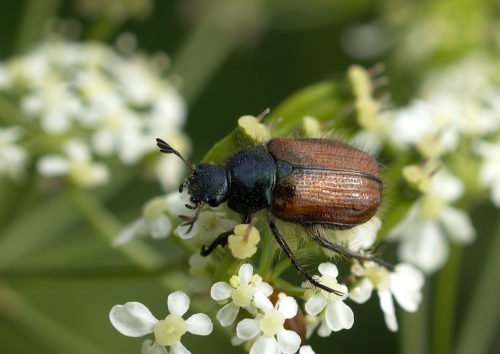Garden chafer; these 8 to 12 mm beetles are somewhat similar to the common cockchafer and summer chafer, but are smaller. The Garden chafer has reddish-brown, hairy wing cases (elytra).
Also known as:
Garden foliage beetle
Garden chafer (Phyllopertha horticola). These 8 to 12 mm beetles are somewhat similar to the common cockchafer (Melolontha melolontha) and summer chafer (Amphimallon solstitiale), but are smaller. Like the last two beetles, the Garden chafer belongs to the the family of scarab beetles (Scarabaeidae). The Garden chafer has reddish-brown, hairy wing cases (elytra).
The beetle lives on plant parts (flower buds) and is found mainly on roses. However, the larvae of the Garden chafer – grubs – are even more damaging. These feed on the roots of plants and grasses and cause root damage to the plants, causing them to dry out.
Garden chafers are mostly found on light soils. In the summer, the beetles lay their eggs about 8 inches (20 cm) deep in the soil, preferably in a lawn or turf.
The natural enemies of this beetle are some species of ichneumon flies and dagger wasps: these insects parasitize on the larvae – moles and birds eat the grubs. At night when the adult beetles fly around, they are also caught and eaten by bats.
Where to find
- Grass (lawn, turf)
- Rose
Control
The larvae of the Garden chafer, the grubs, can be controlled with roundworms (nematodes). Also available for sale is a funnel trap that lures and catches the beetles. This prevents the captured Garden chafers from laying any more eggs.
Prevention
The planting of wild carrot (Daucus carota) contributes to a healthy population of parasitic flies and scoliid wasps. During the time that these insects lay eggs in grubs, they need a lot of energy. The flowers of the wild carrot (one of the few flowering species in that period) offer just that at the right time in the form of nectar.

